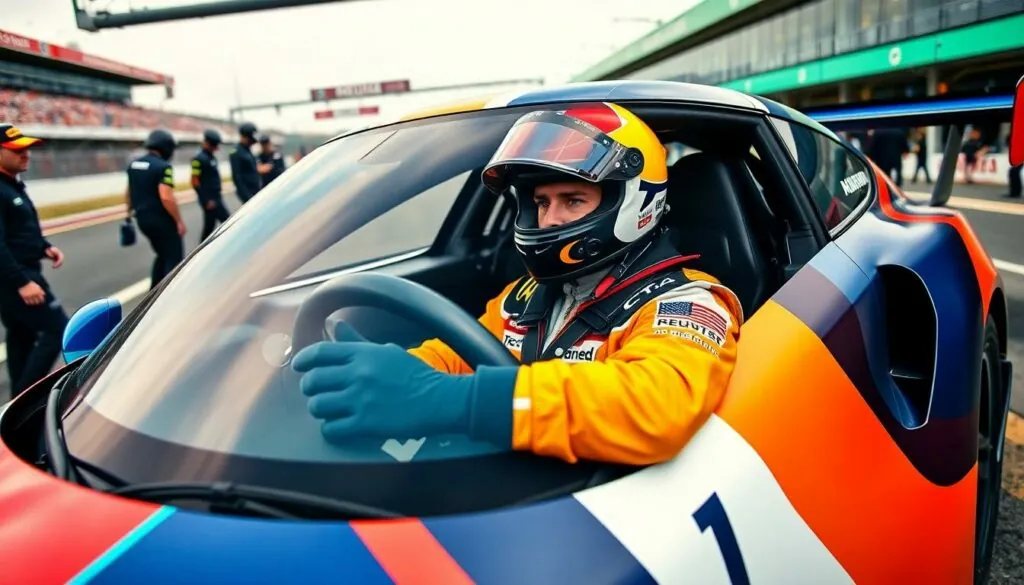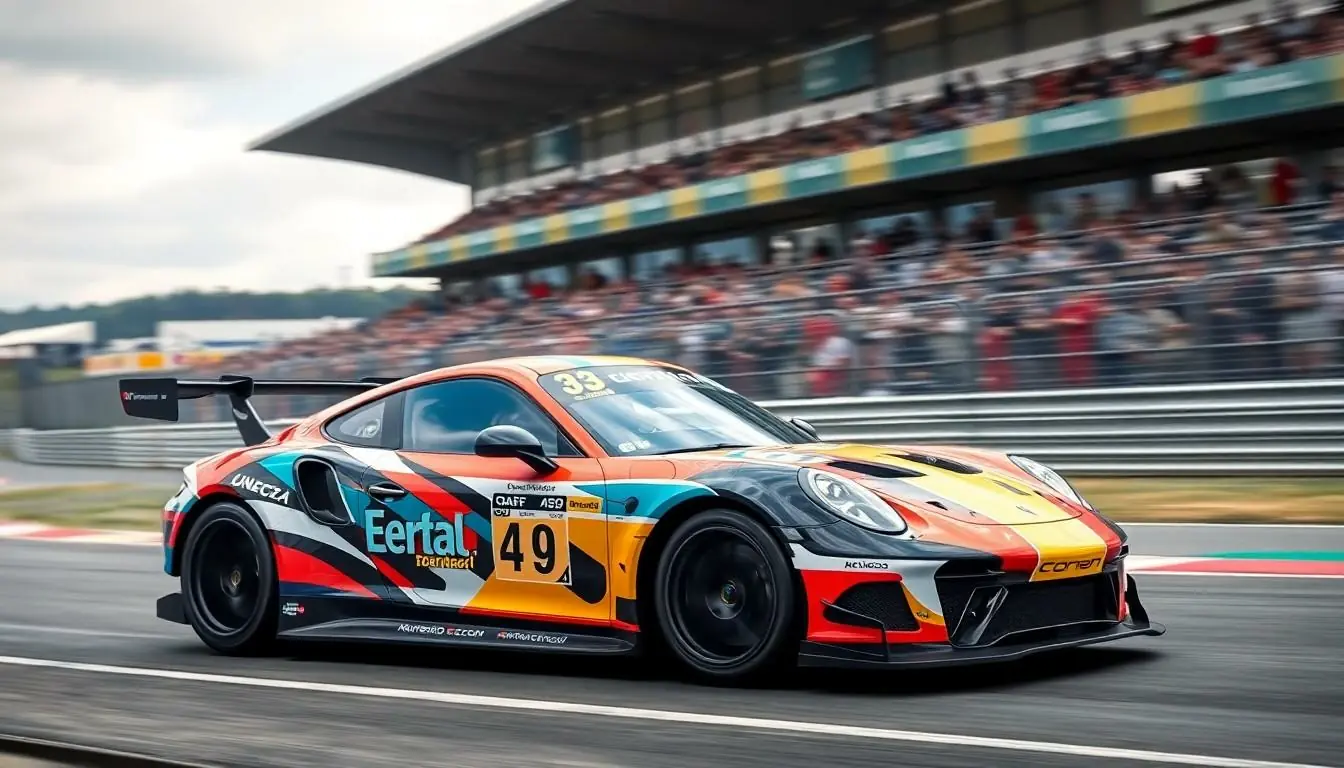In the thrilling world of motorsports, GT4 racing stands out like a neon sign at a black-tie event. It’s where high-performance machines meet adrenaline-fueled drivers, all vying for glory on the track. Picture sleek sports cars, roaring engines, and skilled racers navigating tight corners with precision—it’s a spectacle that keeps fans on the edge of their seats.
Table of Contents
ToggleOverview of GT4 Racing
GT4 racing showcases a vibrant segment of motorsports, featuring vehicles built for competitive endurance and performance. Various manufacturers produce GT4 cars, optimizing them for participation in diverse racing series. Significant organizations sanction GT4 events, including the International GT Association and SRO Motorsports Group.
Vehicles in GT4 racing exhibit a balanced mix of pace and handling. While there’s a focus on driver skill, the regulations ensure competitive parity among different models. Each car, from brands like Aston Martin to Porsche, adheres to technical specifications, maintaining similarities in weight, tire specifications, and power output.
Races take place on renowned circuits, including the legendary Nürburgring and Spa-Francorchamps. Each venue presents unique challenges, enhancing the technical skills of the competing drivers. Spectators experience thrilling races, filled with closely contested battles for position.
Teams prioritize strategy as they navigate pit stops and manage tire wear during the race. Consistency becomes key for drivers aiming for podium finishes. Many drivers enter the GT4 series to step up from previous racing experiences such as karting or lower-tier championships.
Media coverage grows, attracting a larger audience to GT4 racing. Fans engage with their favorite teams and drivers through social media and live events. This heightened interest contributes to the series’ expansion, solidifying its place in the global motorsport landscape.
GT4 racing represents an exciting blend of technology, skill, and strategy, drawing enthusiasts and competitors alike. Through a combination of performance and accessibility, this racing format captivates fans searching for thrilling motorsport action.
History of GT4 Racing
GT4 racing emerged as a distinct category within motorsport, capturing attention with its unique blend of accessibility and competitiveness. The class has evolved significantly since its inception.
Evolution of the GT4 Class
Initially introduced in 2007, the GT4 class aimed to provide a cost-effective alternative to higher-tier racing categories. Cars manufactured by well-known brands began to compete, showcasing their performance on various circuits. The series quickly gained popularity, attracting both amateur and experienced drivers. Regulations focused on maintaining balance among participating vehicles, allowing a wide array of manufacturers to join the fray. Over the years, modifications in technology and rules further refined the competitive nature of the class. As a result, GT4 racing evolved into a premier category, offering an engaging experience for teams and fans alike.
Key Milestones and Events
Several significant milestones have marked the growth of GT4 racing. The launch of the GT4 European Series in 2013 highlighted the class’s international appeal. Subsequently, the expansion into other regions occurred, including Asia and America, allowing a global audience to enjoy the sport. Major events, such as the 24 Hours of Spa and the British GT Championship, showcase intense competition among top teams. Moreover, the introduction of the GT4 specification by the SRO Motorsports Group provided standardized parameters, enhancing fairness among entries. These key moments illustrate how GT4 racing has progressed, solidifying its position in the motorsport industry.
Current GT4 Racing Series
GT4 racing features several competitive series worldwide, showcasing a range of talented drivers and advanced vehicles.
Notable Championships and Their Formats
Championships like the GT4 European Series and the British GT Championship highlight GT4’s global reach. The GT4 European Series consists of multiple races across various iconic European circuits, drawing strong participation from different manufacturers. Meanwhile, the British GT Championship combines sprint and endurance formats, emphasizing strategic teamwork and driver skill. Series regulations promote a balanced performance among diverse car brands, fostering intense competition. Events often attract substantial fan attendance, elevating the excitement of each race weekend.
Leading Teams and Drivers
Leading teams within the GT4 category include renowned names like Team Parker Racing and Aston Martin Racing. Each team features skilled drivers, many with backgrounds in other racing formats. Drivers such as Jamie Caroline and Jordan Albert consistently perform at high levels, showcasing their abilities in fierce competition. Teams also prioritize developing their drivers, ensuring they gain valuable experience on the track. Collaborations between teams and manufacturers help refine car performance, maximizing each driver’s potential during races.
Technical Specifications of GT4 Cars
GT4 cars exemplify a blend of performance and technical prowess, built to excel in competitive racing environments. Each vehicle adheres to specific guidelines that enhance the racing experience.
Performance Features
Performance in GT4 racing stems from strategic engineering and design choices. Most GT4 cars feature naturally aspirated or turbocharged engines producing between 350 and 500 horsepower. Aerodynamics play a vital role, with components like rear wings and front splitters optimizing downforce and stability. Weight limitations commonly cap vehicles around 1,300 kilograms, ensuring nimbleness on the track. With a focus on balance, manufacturers like Porsche and Aston Martin prioritize handling characteristics alongside raw speed. Suspension systems undergo rigorous adjustments, allowing for adaptability to various circuits, thus enhancing overall performance in different racing conditions.
Safety Standards and Regulations
Safety standards in GT4 racing maintain a focus on driver protection and competitive integrity. Each car must meet stringent homologation requirements set by governing bodies, ensuring uniformity across the field. Essential safety features typically include FIA-approved roll cages, fire suppression systems, and harnesses designed to keep drivers secure during high-speed maneuvers. In addition, all GT4 vehicles need to embrace advanced electronic systems for stability control and ABS, enhancing safety without compromising performance. Routine inspections take place before races, with any car failing to meet the established criteria deemed ineligible to compete, reinforcing a commitment to participant safety in GT4 series worldwide.
The Future of GT4 Racing
GT4 racing is evolving rapidly, propelled by innovation and growing competition. The future promises exciting developments in this segment.
Emerging Trends and Technologies
Technological advancements shape the direction of GT4 racing. Electric and hybrid powertrains gain traction among manufacturers, offering enhanced performance and sustainability. Manufacturers like Porsche and Aston Martin explore these options, aiming to meet emerging environmental standards. Aerodynamic innovations focus on optimizing downforce and balance, making vehicles even more agile on the track. Additionally, data analytics tools monitor vehicle performance in real time, assisting teams in making strategic decisions during races. The introduction of driver assistance systems also enhances safety and lowers the learning curve for new competitors.
Potential Growth and Challenges
Growth opportunities in GT4 racing appear promising, as interest increases among fans and participants alike. Expanding series in Asia and America boosts visibility and competition, attracting new sponsors and drivers. Continued manufacturer support fuels development of competitive vehicles, leaving plenty of room for expansion in markets worldwide. Despite these prospects, challenges lie ahead. Maintaining cost-effectiveness while advancing technology poses a dilemma for teams, as balancing budgets and performance remains crucial. Additionally, evolving regulations may impact vehicle specifications and racing formats, requiring teams to stay adaptable in a dynamic environment.
Conclusion
GT4 racing stands as a thrilling testament to the world of motorsports. Its unique blend of high-performance vehicles and skilled drivers creates an electrifying atmosphere that captivates fans and competitors alike. The sport’s evolution since its inception has paved the way for a diverse range of participants and manufacturers, solidifying its place on the global stage.
As technology advances and new trends emerge, GT4 racing continues to push the boundaries of performance and sustainability. The commitment to safety and competitive parity ensures that this dynamic series remains accessible and engaging for both amateur and professional drivers. With its promising future, GT4 racing is set to maintain its status as a premier motorsport experience.








